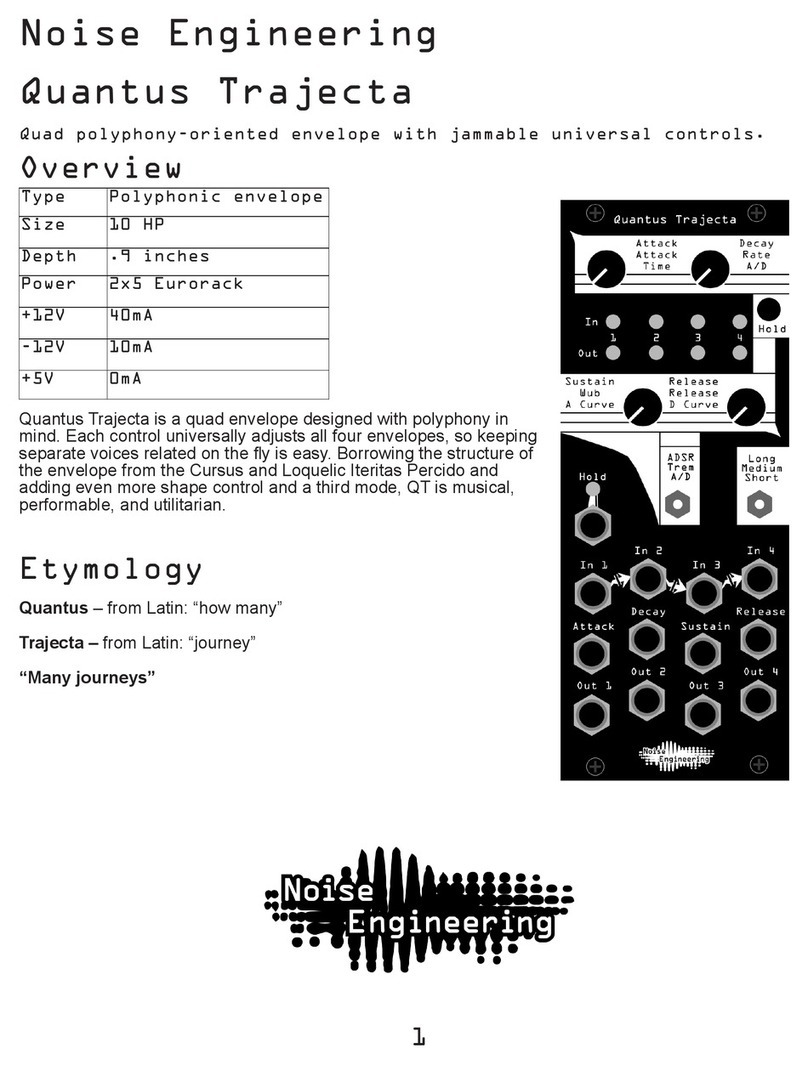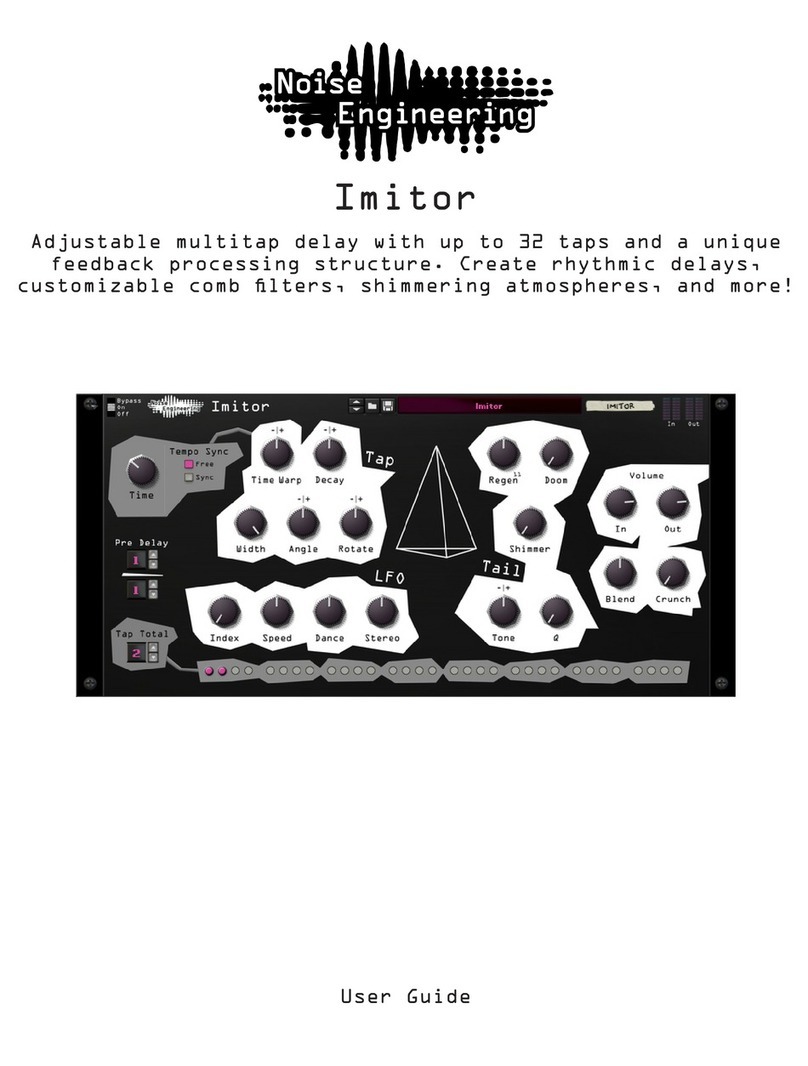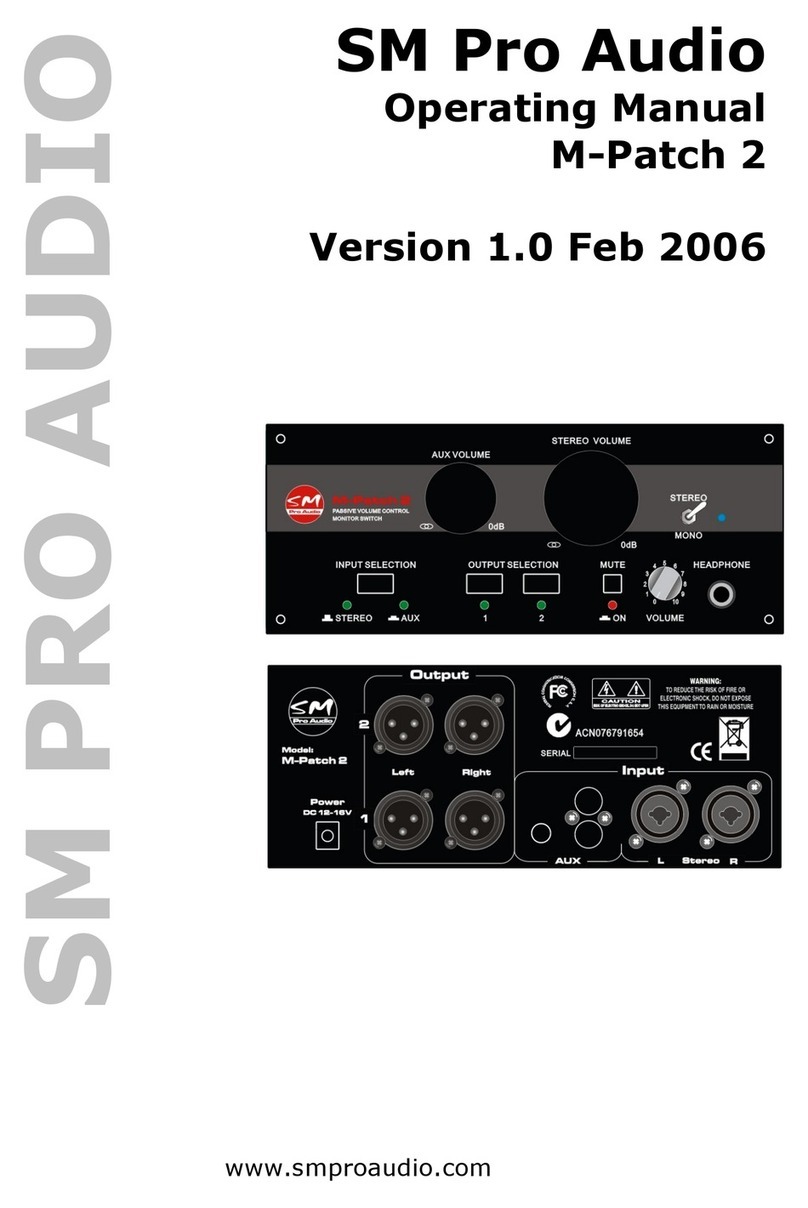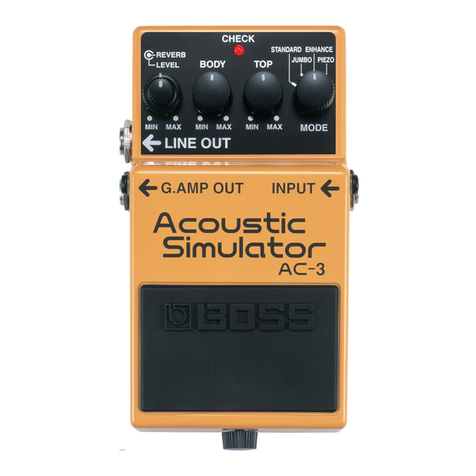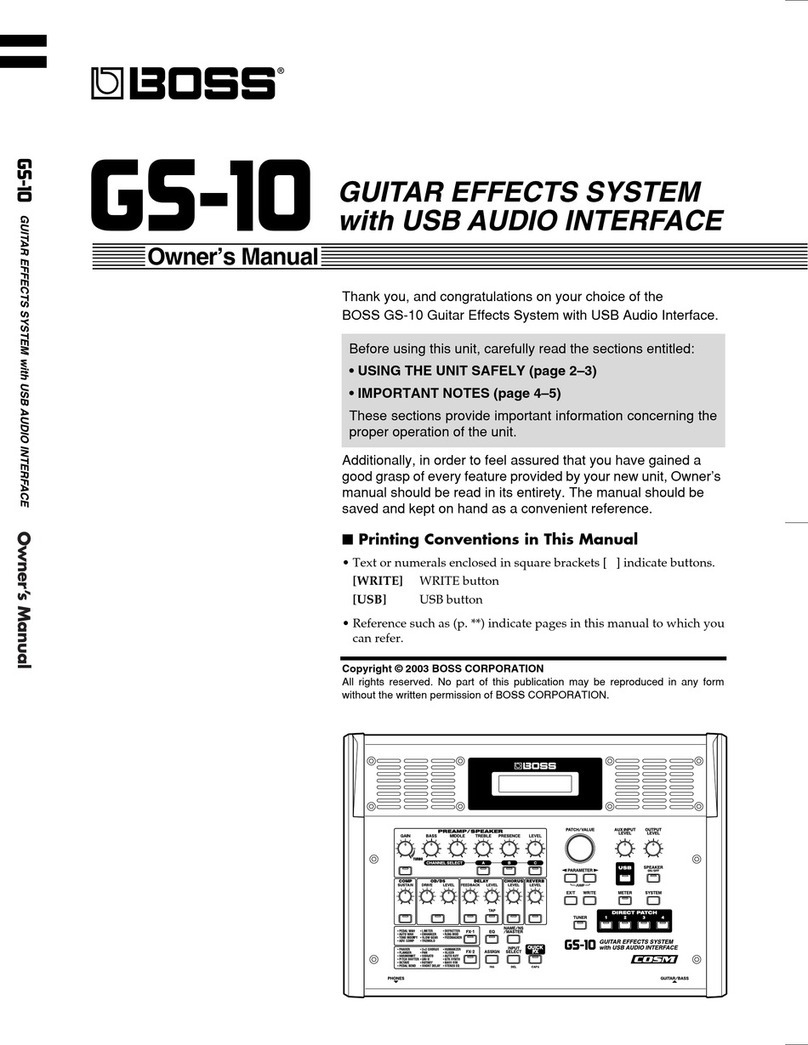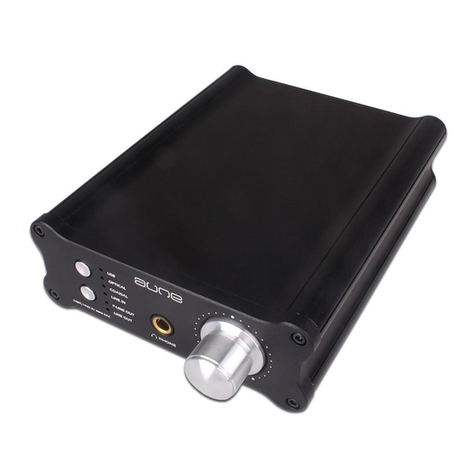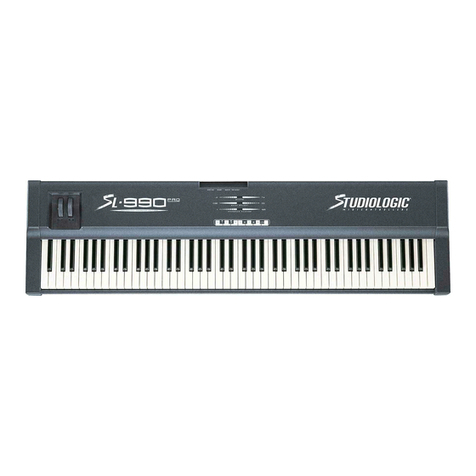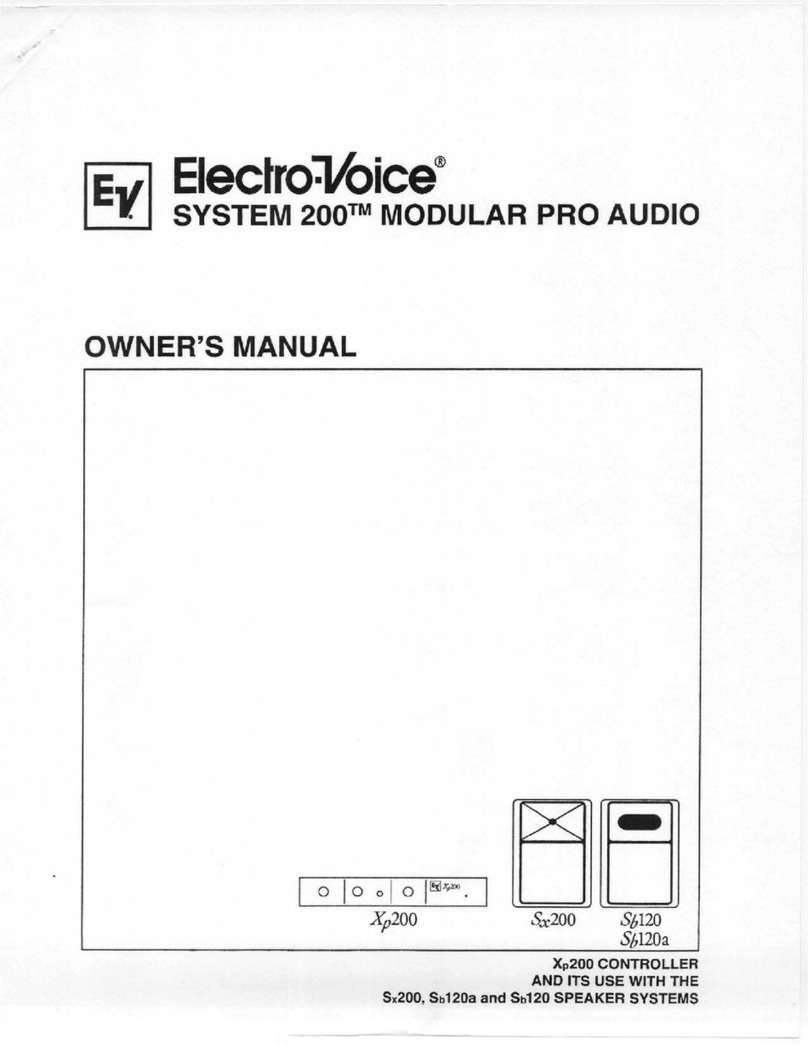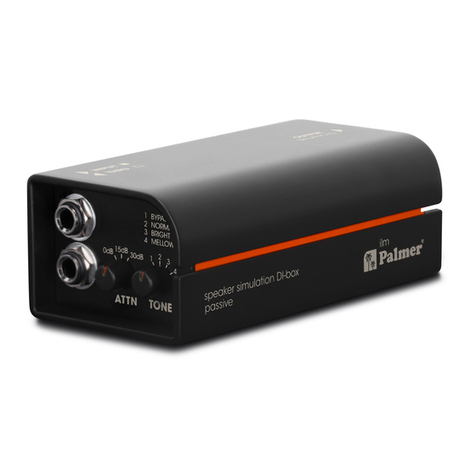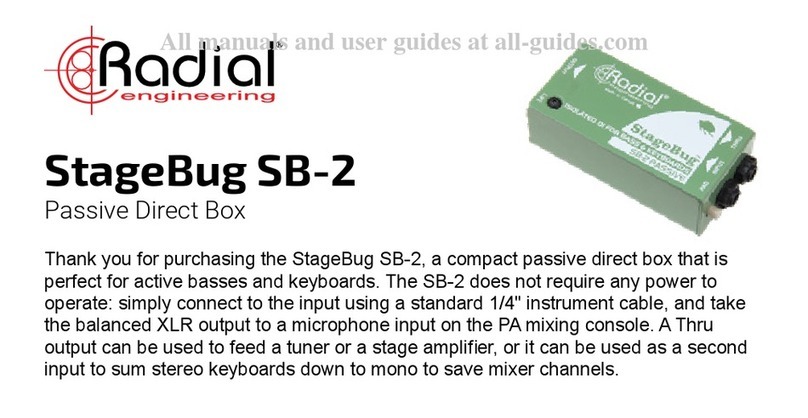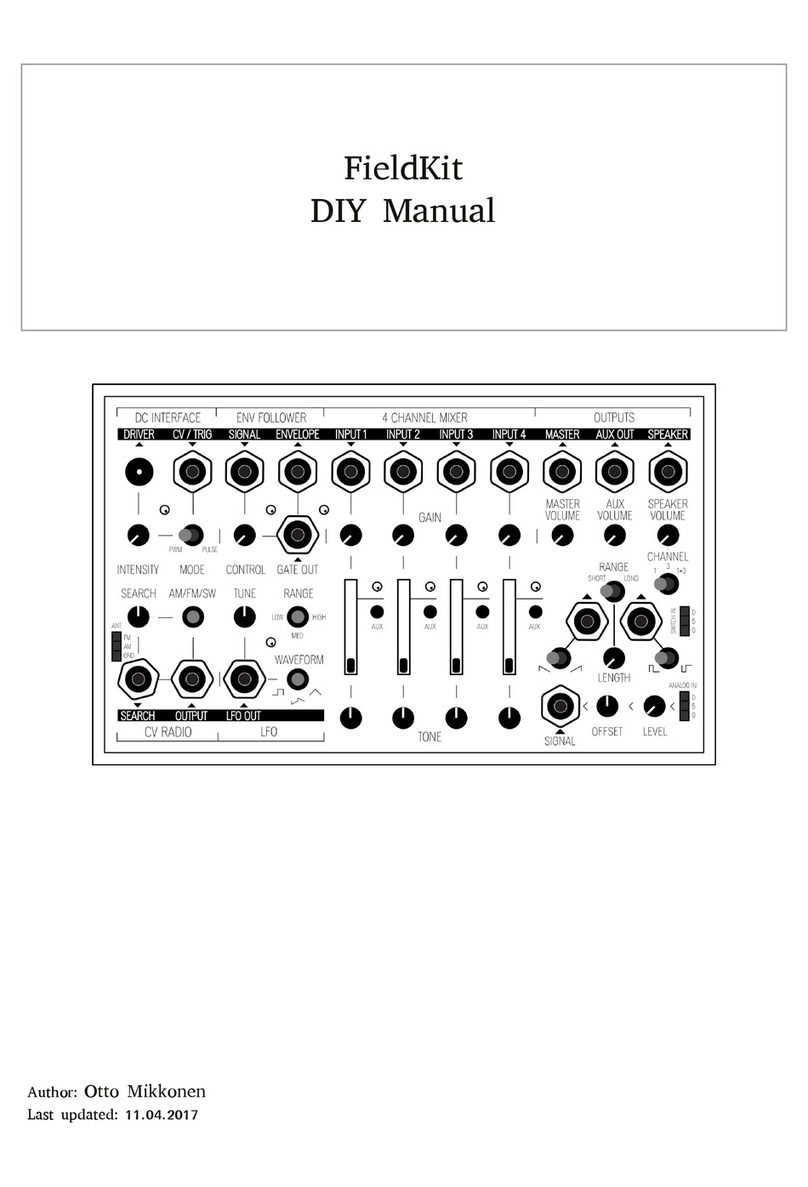Noise Engineering Virt Iter Legio User manual

1
Noise Engineering
Virt Iter Legio
Three-algorithm stereo oscillator with phase modulation and
a vintage-inspired chorus on a exible oscillator/D P
platform.
Type tereo oscillator/
platform
ize 6 HP
Depth .9 inches
Power 2x5 Eurorack
+12V 140mA
-12V 22mA
+5V 0mA
Overview
Virt Iter Legio is a three-algorithm stereo oscillator with stereo phase modulation inputs and a
vintage-inspired chorus. Astute users may recognize the oscillator algorithms – Bass, Harm, and
SawX – from our contributions to the Arturia Microfreak and from our Virt Vereor plugin.
Its simple interface and unique, immersive sound make it a staple for any style of sound design. Use
the hard sync input to add an aggressive edge to sounds when synced to another oscillator, or try
patching VIL’s left and right phase modulation inputs independently for even further sonic
exploration in the stereo eld: trust us, stereo PM is something you’ll want to hear. Turn on the
beautiful, wide chorus and you’ll have an endless supply of beautiful sounds.
Not only is Virt Iter Legio a fantastic oscillator, it’s also a platform: head to the Customer Portal to
swap the functionality of your module to a growing number of alternate rmwares, completely free.
Etymology
Virt -- from Latin: “strength”
Iter -- Iteritas -- from Latin: “repeat”
Legio -- from Latin: “legion, army”
“Army of strong repetitions”
Color code
On boot, the VIL’s LEDs will shine with this color
pattern to indicate that it is running the current VIL
rmware:

2
Power
To power your Noise Engineering module, turn o your case. Plug one
end of your ribbon cable into your power board so that the red stripe on
the ribbon cable is aligned to the side that says -12v and each pin on the
power header is plugged into the connector on the ribbon. Make sure no
pins are overhanging the connector! If they are, unplug it and realign.
Line up the red stripe on the ribbon cable so that it matches the white
stripe and/or -12v indication on the board and plug in the connector.
Screw your module into your case BEFORE powering on the module. You
risk bumping the module’s PCB against something metallic and damaging
it if it’s not properly secured when powered on.
You should be good to go if you followed these instructions. Now go make
some noise!
A nal note. Some modules have other headers -- they may have a
dierent number of pins or may say NOT POWER. In general, unless a
manual tells you otherwise, DO NOT CONNECT THOSE TO POWER.
Warranty
Noise Engineering backs all our products with a product warranty: we guarantee our products to be
free from manufacturing defects (materials or workmanship) for one year from the date a new
module is purchased from Noise Engineering or an authorized retailer (receipt or invoice required).
The cost of shipping to Noise Engineering is paid by the user. Modules requiring warranty repair will
either be repaired or replaced at Noise Engineering's discretion. If you believe you have a product
that has a defect that is out of warranty, please contact us and we will work with you.
This warranty does not cover damage due to improper handling, storage, use, or abuse,
modications, or improper power or other voltage application.
All returns must be coordinated through Noise Engineering; returns without a Return Authorization
will be refused and returned to sender.
Please contact us for the current rate and more information for repairs for modules that are not
covered by our warranty.

Input and output voltages
Virt Iter Legio’s CV-modulation inputs expect signals from 0v to +5v.
The Pitch input’s range is -2v to +5v.
The Sync input responds to a rising edge around +1.6v.
The phase-modulation inputs are AC coupled and respond to any Eurorack audio
signals.
The audio output can reach up to 16v peak-to-peak.
Interface
Pitch (encoder)
Sets the pitch of the oscillator. Turn for ne tuning, press and turn for coarse
tuning.
Pitch (CV)
1v/8va calibrated pitch CV input.
Flavor and Tang
The main tonal parameters on VIL. Their functions change depending on the
selected algorithm: learn more in the section below called “Tone Generation.”
Harm/Sawx/Bass
Changes the oscillator algorithm. More info on each algorithm can be found in the section below
called “Tone Generation.”
II/I/0
Activates the vintage-inspired chorus. 0 is o, I is some, II is lots.
Sync
Hard-sync input.
PM L/PM R
Phase-modulation inputs. Intended for use with audio-rate signals for complex harmonic patches,
similar in sound to FM.
Inputs can be used independently with separate signals, or with a single signal. Patching to the L
input will normal to the right for easy modulation.
Out L/Out R
Main audio outputs.
3

Patch Tutorial
Drone
Virt Iter Legio can be used as a simple drone oscillator: simply monitor the L and R
outputs, try out the dierent settings, and move the parameters by hand or with
CV.
Voice
Patch the Virt Iter Legio’s outputs to two VCAs. Mult the output of an envelope
generator to the CV inputs of your VCAs. Patch a sequencer or keyboard’s pitch
CV to the Pitch input on VIL, and the gate output to your envelope generator.
Monitor the output of the VCAs as a stereo pair.
Try using additional CV sources like envelopes and LFOs to modulate the Flavor
and Tang CV inputs and vary your sound.
Phase Modulation
An additional oscillator can be added to this patch for PM. Try multing your pitch
CV to a second oscillator, then patch its output through an attenuator and into the
L PM input on VIL to create phase-modulated timbres.
Mono
VIL sounds best when used in stereo, but it will work in mono as well: simply
create the initial voice or drone patch with a single VCA using VIL’s L output.
Find more patches in the Virt Iter Legio patchbook.
wapping rmware
Virt Iter Legio’s rmware can be updated by the user via our rmware webapp on the Customer
Portal. Alternate rmwares available now transform the VIL into completely dierent modules.
To update the rmware on your Legio:
1. Turn o the power to your case and unscrew the module.
2. Remove the power connector on the back of the module.
3. Plug a micro USB connector into the port on the back of the module, and the other
end into your computer.
4. Follow the instructions in the webapp.
4

Tone Generation
Virt Vereor contains three dierent algorithms for sound creation: Bass, Sawx, and Harm. These
algorithms were originally developed as oscillators for the Arturia Microfreak and our Virt Vereor
plugin, and now they can be a part of your Eurorack patches, too.
Bass
Some years ago, Bernie Hutchins, retired professor of Electrical Engineering at Cornell University,
wrote a great series called Electronotes . Electronotes #73 includes reference to an algorithm called
Bass (named after a person, not the clef). It's a simple algorithm that uses nonlinearities combined
with quadrature modulation to produce a variety of tones. The Bass oscillator is based o of this
algorithm, with a few Noise Engineering touches (fold anyone?) for more edgy sounds. Flavor
controls the saturation of the cos oscillator. Tang controls a two-stage asymmetric wavefolder, and at
the top 1/6th of the knob noise is added that is mixed in between fold stages, and also phase-
modulates both oscillators.
awx
The SawX algorithm starts with a simple super-saw oscillator, and adds some saw-mod that can be
ethereal or metal. SawX surprised us with its versatility. Flavor controls the gain into a modulus
stage. Tang determines the amount of stereo phase added to the oscillator, and at the top 1/6th of
the knob adds in phase modulation from subsampled white noise.
Harm
The basic Harm oscillator is a sinusoidal additive synth with a slight distortion stage: this time, a
digital implementation of something similar to our analog distortion module Pura Ruina. Flavor
adjusts the relationship between the partials. At zero it is unison, at max it is octaves. The middle
interpolates linearly in frequency. Tang controls an adjustable rectication of the individual partials,
similar to half of a wavefolder. At the top 1/6th of the Tang knob, phase-modulated noise is mixed
into the signal, too.
Design Notes
Virt Iter Legio was a long time coming. Announced in January of 2020 at NAMM, we were planning
to launch soon after but… things happened. VIL has been in some stage of development ever since,
and we regularly received questions about its release without being able to give any sort of denitive
answer due to manufacturing and development hurdles, and parts shortages.
We were able to order a nal prototype in May of 2022 – more than two years after we had hoped it
would be released – and veried the hardware so we could complete the testing of our rst two
rmwares.
We appreciate each and every customer who asked about the Virt Iter Legio over the last couple of
years, and we’ve shared your excitement: we’re incredibly proud to launch the Legio platform, and
we can’t wait to share the other rmwares we’ve been working on.
5

Calibration
Virt Iter Legio features extremely accurate pitch tracking and an autocalibration system. You’ll never
need to manually adjust pitch tracking: power the unit on with nothing patched to the pitch CV input
and the module will calibrate itself during startup.
pecial Thanks
Arturia, especially Seb and Baptiste
Jerey Horton
ElectroNotes
NAMM 2020
All of the patient people who have been waiting since then…
6
Table of contents
Other Noise Engineering Music Equipment manuals
